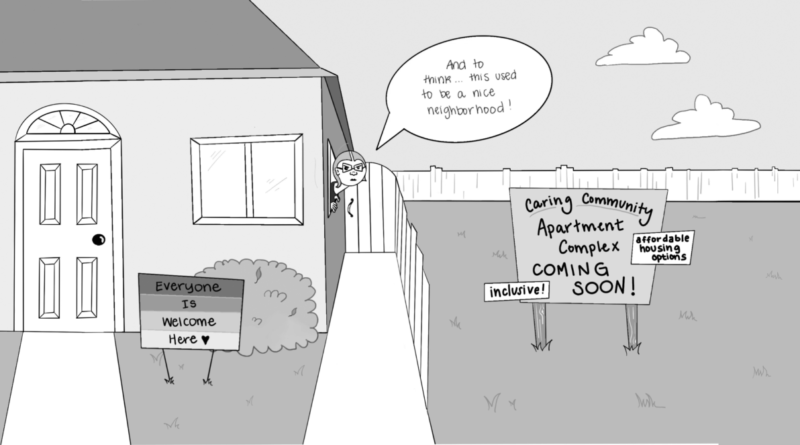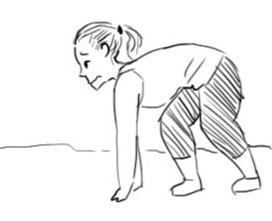OPINION: Davis hides regressive attitude behind liberal politics
EDITORIAL CARTOON: The contrast between how Davis advertises themselves as opposed to the underlying sentiment of some citizens.
By Stella Maze,
BlueDevilHub Staff–
Davis, on the relative spectrum, is fairly liberal. According to bestplaces.net Davis overall voted for democratic presidential candidates for the past twenty years. However, there’s more to being liberal or progressive than voting democrat in presidential elections.
However, a lot of Davis’s liberalism is performative. Performative liberalism occurs when the image and political status of a place does not match its inner workings and concrete actions.
It is a facade, put up to hide the stagnant and unaccepting nature of Davis´ culture.
We are the white moderate democrats who use our votes for Barack Obama to excuse ourselves for crossing the street when we see a Black man walking. Davis is made up of a lot of contradictory actions and empty words.
In 2003 at a home basketball game, between Davis High and Fairfield High, the Davis audience heckled and jeered at the mostly black Fairfield team. Some phrases that were heard and can be watched in the 2009 documentary on the history of Race and Social Justice and the Davis Community called ‘From the Community to the Classroom’ included repeated chanting of “G! P! A!” and “We go to college! You go to jail!”
¨This is not what I would expect from a school in a city like Davis, a city that prides itself on racial sensitivity and enlightened thinking¨ Ian Blair, a Fairfield player who was there that night, said in a letter.
Davis High student Scott Dickey, responded to Blair’s letter with his own, published in the Davis Enterprise, gaslighting him and deflecting responsibility by arguing that because Davis had a black teammate they could not be racist.
“We’re the most conservative liberal town I know of,” Kevin Williams, Davis High History and Race and Social Justice teacher, said.
Williams, a longtime resident of Davis, raised his kids in the town and went to college here. He remembers when a Battered Women’s Shelter was proposed in Davis a number of years ago. The proposal was turned down repeatedly by Davis residents because of concerns of what ‘kinds of people’ it would bring into neighborhoods. Those kinds of people being low income people of color.
While Davis discusses volunteering to feed the homeless and hosts discussions of the importance of diversity, when it comes to actually passing laws that will affect lives, the momentum is lost.
After a series of incidents of racism and hate in Davis (see infographic below), a student group was formed with leadership from community activist Jann Murray-Garcia, that called for and ensured the creation of a Race and Social Justice course.
The course titled ‘Race and Social Justice in U.S History’ at Davis High began in 2007.
As another result of the 1983 murder of Thong Hy Huynh, a Vietnamese student at Davis High, in 2010, Friendship day was created at Davis High. Friendship day is a day dedicated to bringing kids from all backgrounds on campus together and lessening racial tensions that led to the death of Huynh.
Though Friendship Day has brought positivity to campus and community, hate crimes have continued.
Williams said that even the RSJ course is an example of Davis’ superficial virtue signaling.
“I think the idea of RSJ fits the Davis community very well and it gives us ( to say) ‘hey look, we’re more progressive,’ in a way that doesn’t actually affect your life living in town,” Williams said.
Davis’s median housing price is over $700,000, while the median income of Black and Latinx is between $55,000 and $65,000. Ideally one can afford housing in California that is about 4.9 times their median income (as of 2017 statistics).
Applying that rule to the statistics of California and Yolo County, Black and Hispanic families would only afford two fifths the amount of the average housing price in Yolo County.
The statistics are unsurprising when looking at the modern day disparities from a lens of redlining history.
In the 1930s, redlining became an official system of the government tokeep families of color out of white neighborhoods. The way it worked is that banks would purposeful and targetedly decline home loans to non-white people.
Maps were literally sectioned off with red lines that indicated the areas of each town that had property values with the highest likelihood to decrease. These are the places that people of color were funneled into.
Because there was never a national or concrete effort to reach equitable housing status for people of color, redlining is a significant reason for the racial layout of the country still, including in Yolo County.
Davis High senior, Julian Johnson has lived in Davis since 2014 after he moved from the Bay Area and says he has noticed the housing issues.
“I think there’s still some undercover shady things, …it’s very progressive but the housing prices kind of price Black people out,” Johnson said.
Similarly to Williams, Johnson feels a difference between Davis’s image and its real attitudes.
He, personally, has experienced various instances of explicit racism in Davis as well as the general uncomfortability that comes with being a person of color surrounded by white people.
“When I first moved it was a total shocker not seeing many people like me,” Johnson said.
Johnson shared that he experienced being called the n-word in the Davis Joint Unified School District and one instance when wore a chain to school as an accessory when one girl said to him ‘who’s your owner?”
Davis High senior Bryce Barker has grown up here in Davis. He said that he really appreciates the side of Davis that is filled with safety and opportunity.
“(However) I don’t think I’ve had a teacher of color at this school,” Barker said.
Once again, an example of how there are still problems to work on solutions for and environments to make safer for every person of every race in this town.
We can get there, but it’s important not to advertise ourselves as the perfect liberal town as we do today when there’s a lot for us to work through as a community.



